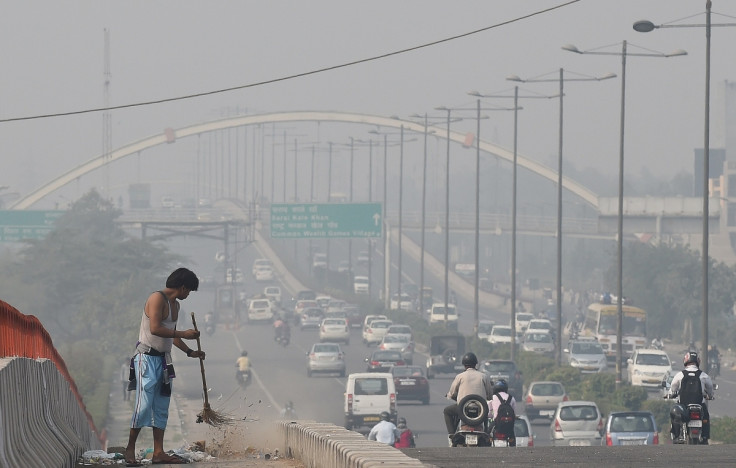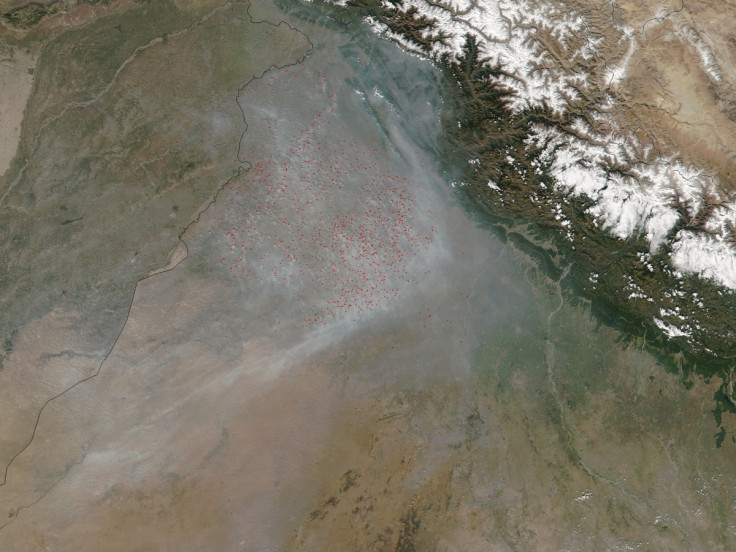India: Severe warning issued for pollution levels in Delhi as temperatures start dropping

The deadly smog that covers the world's most polluted city, New Delhi, during the winter months is back, only much sooner bumping up the polluted air quality level to "severe". Pollution levels in the city are expected to be at its peak on 5 November, according to a forecast.
The System of Air Quality and Weather Forecasting And Research (SAFAR) has said the emissions of PM2.5 particles, a widely accepted index for pollutants hampering air quality is expected to reach 252 micrograms per cubic metre (mpcm) on Thursday which is classified as "very unhealthy". It ranks just above the worst category of air pollution level. The World Health Organisation's (WHO) "moderate" limit of the PM2.5 particles is 100mpcm.
Under these conditions there can be significant aggravation of heart or lung diseases and possible premature mortality in persons with cardiopulmonary disease and the elderly. There can also be increase in respiratory effects in the general population.
Through the whole of last week the skies in the capital could be seen engulfed in a thick haze with extremely high level of suspended particulate matters keeping the air quality "poor". "I can literally feel the particulate matter when I breathe. We know winters are bad due to the smog but this is just something else. The worst is if your are travelling with open access to air like a two wheelers or some public transports like rickshaws," Kingshuk Dutta a resident of the city who travels a 15km distance every day on his two wheeler, told IBTimes UK.
Although the deadly smog has been a part and parcel of the city, the reasons for Delhi's air reaching its most polluted state of late has been a deadly combination of cloudy skies and crop burning in the neighbouring states of Haryana and Punjab. Pollution levels have sky rocketed in October when farmers started illegally burning paddy stubble in their fields. The picture below shows a recent satellite image of the state of Punjab which borders the National Capital Region (NCR) where Delhi is situated.

This is in addition to the alarming levels of pollution caused by the large number of private cars. The government in Delhi 10 years ago had forced all public transport in the city to use cleaner-burning compressed natural gas (CNG). However, what it did not fathom is the monumental increase in the number of private cars running especially on diesel, which is known to cause serious emissions of PM2.5 particles. These pollutants also have effects for the rest of the world as among them are greenhouse gases such as ozone and carbon dioxide, which will contribute to future climate change.
The government has encouraged more and more people to use public transport or engage in car pooling in these desperate times but not much success has been achieved. To discourage the sale of diesel vehicles a green tribunal in the country issued a directive to ban all diesel cars that were more than 10 years old from the roads. However, it is not clear if this attempt can curb the use of private cars.
The NCR region sells both petrol and diesel at one of the lowest rates in the country. Added to this, the state of Delhi also has one of the lowest tax rates in the country when purchasing a vehicle. This has led to many investing in new vehicles every year to cut down on their daily commuting costs.
Stench adding to the woes
If the dense smog this winter was not enough, Delhites have also had to contend with the horrible stench around them. Sanitary workers in the city's eastern part were on strike protesting against poor salaries for almost two weeks. They refused to pick up garbage and even dumped piles of trash in the streets as garbage trucks refused to show up. Even though the strike was called off on 25 October, a huge backlog has led to piles of dump just being stranded in the city's eastern part.
Residents complained that it was irresponsible for workers to abandon the city in the middle of the festival season, a time when trash volumes have been known to spike. "The week the workers went on strike our trash was not cleared for five days in a row until the municipality truck came. Our neighbourhood has three mini dumpsters now as we don't have any place to take the trash to," Amarjit Singh, a resident of the busy neighbourhood of Karol Bagh in central Delhi, told IBTimes UK.
Apart from Delhi, India is home to 13 of the world's 20 most polluted cities according to WHO. The Delhi government experimented with a car-free day for a few hours on 22 October, which led a short-term drop in dangerous pollutants. It is to be seen if such measures can prove to be helpful as a long winter awaits and Delhi's pollution woes may just get worse.
© Copyright IBTimes 2024. All rights reserved.





